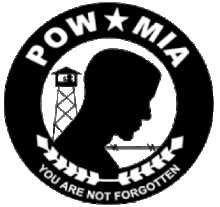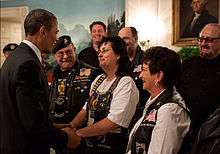Rolling Thunder (organization)
 | |
| Motto | We will not forget |
|---|---|
| Formation | 1987, incorporated 1995 |
| Type | 501(c)(4) non-profit |
| Purpose | To bring full accountability for the 'Prisoners Of War' and 'Missing In Action' of all U.S. wars |
| Headquarters | Neshanic Station, New Jersey |
Region served | International |
Membership | 90 Chapters |
| Website |
rollingthunder1 |
Rolling Thunder is a United States advocacy group that seeks to bring full accountability for prisoners of war (POWs) and missing in action (MIA) service members of all U.S. wars. The group's first demonstration was in 1988. It was incorporated in 1995, and has more than 90 chapters throughout the US, as well as overseas.
Their main annual event occurs on the Sunday before Memorial Day, in which members make a slow motorcycle ride, called the "First Amendment Demonstration Run" or "Ride for Freedom," on a dedicated, closed-off, pre-set route through Washington D.C., leaving the Pentagon parking lot at noon, crossing the Memorial Bridge, and ending at the Vietnam Veterans Memorial ("the Wall").[1][2] During the Rolling Thunder weekend, members and supporters spend time at the Thunder Alley (the official vendor site for the event[3]), visit significant areas of Washington D.C., particularly the numerous memorials, and hear speeches given by members, supporters, military officials and politicians.
History

In 1987 Rolling Thunder made its first ride to the Vietnam War Memorial.[4]
Ray Manzo, a former United States Marine Corps Corporal,[5] U.S. Army Sergeant Major John Holland (Ret.), Marine First Sergeant Walt Sides (Ret.) and Sergeant Ted Sampley (Ret.) are the four men that are credited with starting Rolling Thunder.[6]
In 1987, Manzo visited the Vietnam Veterans Memorial in Washington, D.C., talked with fellow veterans, and first learned that American servicemen had been abandoned in Southeast Asia at the end of the Vietnam War. This was counter to his Marine Corps training to leave no man behind, and he became consumed with the idea that he must do something to bring attention to this issue. Manzo attended a POW/MIA vigil sponsored by the Vietnam Veterans Motorcycle Club when the idea came to him to host a motorcycle rally in the nation's capital to show the country and the world that U.S. prisoners of war and missing in action (POW/MIA) still mattered to their fellow servicemen and the country for which they sacrificed their freedom. [7]
Manzo drafted a letter for a call to action and began mailing it to motorcycling publications. He enlisted fellow veterans from the Washington D.C. area to help him through the red tape of requirements. Sgt. Major John Holland was experienced in government legislation and included 1st Sgt. Walt Sides, and Washington activist Sgt. Ted Sampley also joined them. These were the founders of Rolling Thunder.[8] Ted Sampley's colleague, Bob Schmitt, coined the phrase "Rolling Thunder". While staring at the Memorial Bridge and envisioning Manzo's dream, he said, "It will be like the sound of rolling thunder coming across the bridge."
On Memorial Day 1988, Cpl. Manzo recruited 2,500 men and women to attend Rolling Thunder I.[4]
Rolling Thunder Run to the Wall
| Rolling Thunder Run to the Wall | |
|---|---|
 The Rolling Thunder Run on Arlington Memorial Bridge in 2010 | |
| Genre | Motorcycle rally |
| Begins | Sunday, Memorial Day weekend |
| Frequency | Annual |
| Location(s) | Washington D.C. area |
| Inaugurated | 1987 |
| Previous event | May 26, 2013 |
| Next event | May 25, 2014 |
| Attendance | 500,000 (2018) |
| Organised by | Rolling Thunder |
| Website |
rollingthunderrun |
The First Amendment Demonstration Run, formerly Rolling Thunder Run to the Wall, is a motorcycle rally sponsored by the Rolling Thunder organization. The ride begins on Sunday at the Pentagon after a "blessing of the bikes" at the National Cathedral on Friday and associated events end on Monday.[9]
Beginning in 1987 and continuing through the present, Rolling Thunder has conducted the Run to the Wall on the Sunday of Memorial Day Weekend to show their continued support for the efforts to find lost service men and women of past conflicts.[10] In May 2001 the estimated number of motorcycles involved in this rally was 200,000.[11] The event drew an estimated 350,000 motorcyclists in May 2008,[10] and 500,000 in 2018.[12]
Chapters
Rolling Thunder has 88 chapters covering 29 states all of which are governed by the same constitution and bylaws. Many of Rolling Thunder's members are veterans; however, that is not a requirement for membership.
Rolling Thunder also allows for the formation of new chapters worldwide. All chapters of Rolling Thunder have their own president and board members and are accountable for fund raising proceeds and tax information. New chapters must have a minimum of 20 members including the president and board members. Each Rolling Thunder chapter is required to have a unique patch specific to only that chapter with no resemblance to another, and without infringing on any trade marks.[13]
Charities
Rolling Thunder has expanded its operations to include Rolling Thunder Charities as of 2007, a class 501(c)(3) non-profit organization. This part of the organization adheres to the same laws that govern its parent corporation. Rolling Thunder Charities was designed to help members as well as U.S. Military troops and their families that are in need of financial help. Rolling Thunder Charities sells Rolling Thunder memorabilia and conducts other fundraising activities.
Legislation
Rolling Thunder was influential in the passing of the Missing Service Personnel Act of 1993. The bill states that a service member cannot be listed as killed in action (KIA) without substantial evidence. In 1995 Rolling Thunder Inc. won approval from the United States Government for a POW/MIA postage stamp to be put in circulation and the organization continues to work with the U.S. Senate and House of Representatives on new bills for the return of, and information about, servicemen and women. Rolling Thunder co-authored the 2006 Respect for America's Fallen Heroes Act.[14]
Criticism
The Economist said the organization "was founded...to advance a specific crackpot belief: that successive Republican and Democratic administrations have concealed evidence that American captives are being held alive in South-East Asia."[15]
References
Notes
- ↑ http://rollingthunderrun.com/general-information-and-faq/
- ↑ Rolling Thunder - Florida
- ↑ Rolling Thunder Run home page
- 1 2 Bordner, Linda. "The History of Rolling Thunder's "Run to the Wall"". U.S. Veteran Dispatch. Archived from the original on 3 June 2011. Retrieved 31 May 2011.
- ↑ Ray Manzo biography, Rolling Thunder, archived from the original on 2013-02-01, retrieved 2012-09-20
- ↑ "Archived copy". Archived from the original on 2013-03-05. Retrieved 2013-02-04.
- ↑ "77th Annual 2017 Sturgis Motorcycle Rally". Retrieved 31 July 2017.
- ↑ Rolling Thunder History, Rolling Thunder, archived from the original on 2013-03-05
- ↑ REBECCA FELDHAUS ADAMS (May 27, 2018), Bikers From Across America Ride To Remember Soldiers 'Unaccounted For', NPR
- 1 2 "'Rolling Thunder' Honors U.S. Military With Annual Biker Pilgrimage". Fox News. 25 May 2008. Retrieved 31 May 2011.
- ↑ Rolling Thunder rides to remember POW-MIAs- CNN.com
- ↑ Sarah Konsmo (May 27, 2018), Thousands of motorcyclists roar into DC for Rolling Thunder, WUSA
- ↑ Official Website
- ↑ Rob McIlvaine (May 31, 2011). "Thunder rolls in waves across nation's capitol". US Army News Service.
- ↑ "History and Harleys", The Economist, May 31, 2014
Further reading
- "'Rolling Thunder' honors U.S. military with annual biker pilgrimage". Fox News and Associated Press. May 25, 2008. Retrieved May 21, 2014.
- "Thousands of bikes coming to DC area for Rolling Thunder". WUSA television. May 19, 2014. Retrieved May 21, 2014.
- Fazzalaro, Kristina (May 20, 2014). "Ten memorial day getaways not on the beach". Anchorage Daily News. Archived from the original on May 21, 2014. Retrieved May 21, 2014.
- Moelker, Rene (2014) "Being one of the Guys or the Fly on the Wall? Participant Observation of Veteran Bikers." in (eds.) J. Soeters, P. Shields, S Rietjens. Routledge Handbook of Research Methods in Military Studies New York: Routledge. pp. 104-114.
External links
| Wikimedia Commons has media related to Rolling Thunder (organization). |